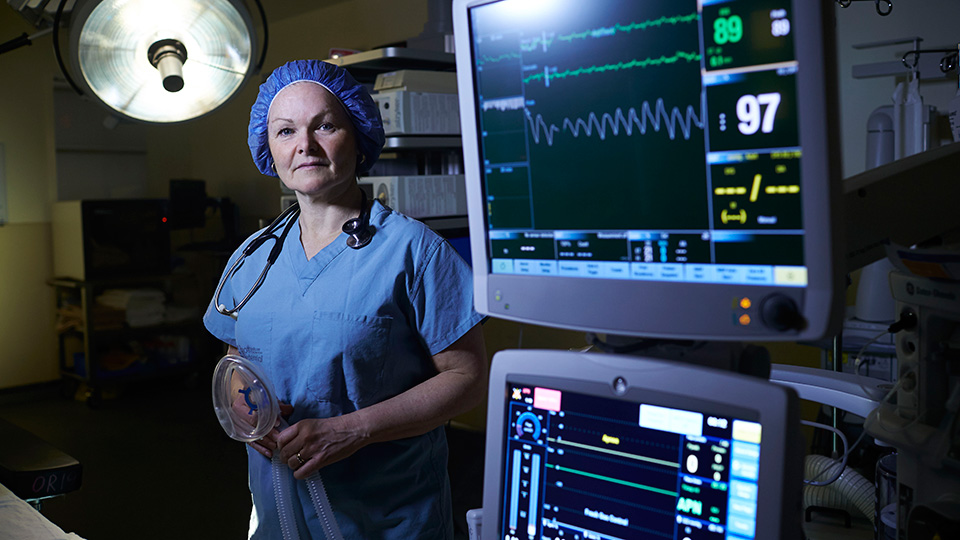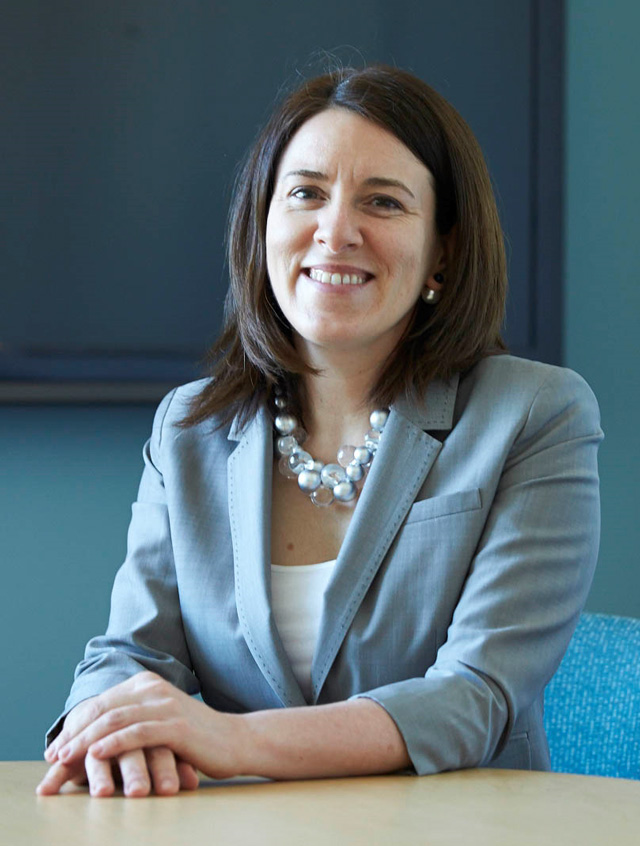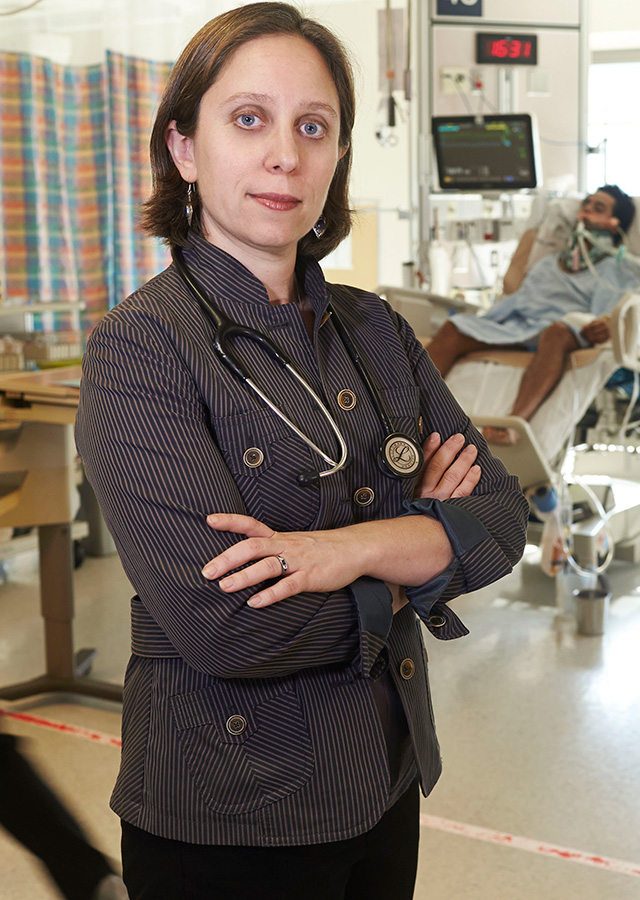Is there still a place for opioids?

Doctors are grappling with how to relieve acute pain while minimizing opioid use and averting descent into chronic pain
June 13, 2016

Dr. Bev Orser is concerned with the effects of opioid use, but wants to ensure her patients get the pain relief they need.

Dr. Frances Wright is a surgeon who specializes in breast cancer and melanoma.
In September 2015 Anita Shedletsky’s lumpectomy revealed cancer cells in her left breast. Very quickly her surgeon, Dr. Frances Wright of Sunnybrook’s Odette Cancer Centre, had Shedletsky, 67, back on the operating table to determine if the cancer had spread to nearby lymph nodes. The surgery was quick and the results encouraging; Shedletsky’s sentinel nodes were cancer free. But soon after the procedure, Shedletsky developed swelling in her armpit. “It felt like I had half a tennis ball under my arm,” she says. The pain was sharp and radiated into her breast and back. She couldn’t sleep and feared picking up her grandkids or even a grocery bag. For the pain Wright prescribed gabapentin, an anticonvulsant drug that helps with some neuropathic pain. After 10 days, Shedletsky felt good enough to quit the drug. She’d had the model experience—immediate pain relief without the side effects. And, she didn’t have to take opioids. “The idea of opioids does not thrill me,” she says. “There’s no way I wanted to go near them unless I really had to.”
Opioids—Hydromorph Contin, morphine, fentanyl, codeine and the like—are a mainstay treatment for acute surgical pain and, controversially, for many chronic pain conditions. Long-term use can lead to dependence, severe addiction and even death. Although fatal overdoses via the illicit opioid market get most of the media attention, physical dependence and other harms resulting from well-intentioned treatment of chronic pain remain an insidious problem that the medical community is working to solve.
This year the Centers for Disease Control and Prevention (CDC) published a stark recommendation: prescribe opioids for chronic pain only for exceptional cases and in limited doses. It harkens back to a level of caution held some 30 years ago, when opioids were prescribed for either severe acute pain or cancer pain, generally at moderate doses. This caution began loosening in the 1990s, after a few scientifically weak but influential studies suggested opioids could be safely used to treat chronic pain, and the pharmaceutical industry heavily marketed “safer,” slower releasing opioid products. Altogether, it was enough to sway the pain management field, which was undergoing a shift, moving to more assertive treatment of all types of pain. In this climate, opioids steadily became commonplace for most types of pain, whether the result of minor dental surgery, a knee replacement or a litany of chronic conditions.
Since 2008 opioid consumption in Canada has increased by 70%, and we now have the second highest rate of opioid prescriptions in the world. (The U.S. has the highest.) “It’s easier to prescribe a drug than to not prescribe one,” says Dr. David Juurlink, a Sunnybrook internist and scientist at Sunnybrook Research Institute (SRI). “In the context of pain, doctors were taught that prescribing opioids more liberally was the right thing to do.”

Dr. Hannah Wunsch found doses of opioids are getting stronger for low-risk surgeries.
Not only has prescription frequency skyrocketed, but doses have, too. A recent study led by Dr. Hannah Wunsch, a critical care doctor and senior scientist at SRI, analyzed some 14 million U.S. pharmacy and medical claims of 18-to-64-year-olds who’d undergone various low-risk surgeries. (She used an American database that captures people younger than 65.) She found that about 80% of the patients filled an opioid prescription within one week of surgery, though Wunsch cautions that the data do not confirm whether the patients actually consumed the drugs. The study also found that the prescribed daily doses for those surgeries have jumped significantly in 10 years. “These surgical procedures [hernia repair, knee arthroscopy, carpal tunnel release] haven’t changed much over the years—in fact, they’re getting less and less invasive, so one shouldn’t expect to see such an increase in dosing,” Wunsch says. Speculating on the reasons, she says, “it may be easier to ensure someone has more opioid from the outset rather than having patients come back to be reassessed for pain control.” Of course, this practice can be counterproductive as patients become increasingly tolerant. “Sure, people will often tell you they feel better for a week or two,” says Juurlink. “But over time, the effects of the drug attenuate and doses tend to creep up. Before you know it, patients are on high doses and that’s when the harms can mount.”
Research published in the last several years has looked not only at the harmful effects of sustained opioid use (deaths, addiction rates, car accidents), but also the efficacy of other types of pain medications, which could work together in smaller doses to lessen the need for opioids, particularly after surgery. Even acute pain from minor procedures can become chronic, potentially setting patients up for the vicious cycle of opioid therapies. Using this multimodal approach medical researchers are hoping to stem pain at the outset, with the broader goal of reining in a culture of lenient opioid-prescribing practices.
One of these alternatives is gabapentin, which got Shedletsky through her persistent postsurgical pain. Along with a similar drug called pregabalin, gabapentin was first used to treat seizures; it was also found to do well with certain types of neuropathic pain. More recently, as wariness builds around opioid use, gabapentinoids have been increasingly prescribed to treat acute postsurgical neuropathic pain. Shedletsky’s surgeon, Wright, has been prescribing gabapentin preoperatively along with Tylenol since the early 2000s. Wright specializes in breast cancer and melanoma. For certain procedures that carry the risk of chronic pain—mastectomies, groin or axillary lymph node dissections, an amputation for a melanoma—she’ll prescribe gabapentin for one month after surgery. Wright has found gabapentin to be helpful. “The nurses in the recovery unit tell me that patients are using less opioids, and studies support these observations,” she says, adding that gabapentinoids could play a role in preventing lingering pain. “If acute pain is controlled more aggressively immediately after surgery, patients may be less likely to develop chronic pain.”
These drugs, however, are not a panacea. Gabapentinoids alone aren’t sufficient to treat severe postsurgical pain. Dr. Beverley Orser, Sunnybrook anesthesiologist and researcher in SRI’s Hurvitz Brain Sciences Research Program, has been studying gabapentinoids to understand how they work in the brain and spinal cord, and how they interact with other drugs. Gabapentinoids, she says, “have some narcotic-sparing effects postoperatively and may be helping prevent the transition from acute to chronic pain. But, these drugs can cause memory loss, intense fatigue and dizziness, so they really have to be tailored to the patient and the condition.” For example, Orser’s lab has been finding that gabapentinoids may increase the severity of sleep apnea when used with opioids. “As our population becomes larger and sleep apnea becomes more of a problem, combinations of classes of drugs must be used with caution,” she says. “We’re still learning how to optimize the use of gabapentinoids for perioperative care; it hasn’t found its place yet in practice.”
Along with studying available drugs like gabapentinoids, Orser’s lab is looking for new targets, to understand the receptors that are involved in pain pathways in an effort to develop new drugs. “We have many more modalities than were available in our mothers’ time, but the challenge is to keep expanding that armamentarium, while optimizing the use of the drugs we have now.”
Orser calls the multimodal approach “one of the most impactful changes I’ve seen in practice. There’s awareness and investment in ensuring our patients are as comfortable as possible in the postop period, as safely as possible.”
Another important tool has been celecoxib (Celebrex), a nonsteroidal anti-inflammatory drug (NSAID) in the same class as acetylsalicylic acid (Aspirin), ibuprofen (Advil) and naproxen (Aleve). Unlike Aspirin and Advil, however, Celebrex doesn’t increase bleeding, which is crucial during surgery. It’s most effective for inflammatory pain—from arthritis, broken bones or other musculoskeletal damage. Dr. Stephen Choi, a Sunnybrook anesthesiologist and researcher with SRI’s Holland Bone and Joint Research Program, was part of a team that analyzed the effects of administering celecoxib before non-cardiac surgery. “We found that it does decrease pain and opioid consumption somewhat,” Choi says. “The takeaway is that it helps best in combination with other adjuncts, like pregabalin, to make a real difference in opioid use.” In his practice, Choi takes a cautious approach to pain management, starting with Tylenol and NSAIDs, and supplementing as needed. “The majority of people are fine with Tylenol, NSAIDs and some opioids,” he says. “But on their own, these alternative medications just do not provide enough pain relief for most people after major surgery.”

Dr. Stephen Choi takes a multimodal approach to pain relief, which he says is needed when it comes to major surgery.
Safely maximizing pain treatment while minimizing opioid consumption can be tricky business. Tinkering with drug combinations and doses must happen on a case-by-case basis in a way that balances side effects with patient expectations, needs and existing conditions. Recently Choi treated a former heroin addict who was undergoing major orthopaedic surgery. Although drug-free for three years, the patient was naturally terrified of being exposed to opioids that could awaken their addiction. Choi was sympathetic but realistic with his patient. “The likelihood of not using opioids for a surgery like this was nil,” he says. “So we had a very aggressive tapering schedule, and I called the patient every day to check in.” Along with opioids, Choi prescribed Tylenol, anti-inflammatories and pregabalin.
Before resorting to opioids, however, Choi was able to administer what’s called a nerve block, in which a local anaesthetic is injected around the surgical site, effectively freezing the nerves so they’re unable to transfer signals to the brain. Patients feel zero pain for 12 to 18 hours, but they also lose mobility in that region, which is problematic for recoveries involving physical therapy. For Choi’s formerly addicted patient the nerve block was a worthwhile treatment; it delayed opioid use at least for a short time, and during the most painful time of recovery. As a researcher, Choi is looking for ways to extend nerve blocks. “We’ve put catheters in that can extend infusions for anywhere up to two to seven days,” he says, noting that this method is most useful for upper extremity procedures—like shoulder surgery—after which patients are immobilized in a sling for several days. Long-term nerve blocks are less useful for knee or hip replacements that require intense physiotherapy.
Individually, nerve blocks, gabapentinoids and NSAIDs are nowhere near a glaring replacement for opioids; for most acute surgical pain, opioids are too effective. Researchers now have a better handle on the trajectory of acute pain, however, which could ultimately help curb opioid use in the long run. “There’s been a real transition in the way we view pain,” says Orser. “Not only are we striving to keep patients comfortable to the point that we have a dedicated team in the post-op period, but we recognize that it’s important to prevent the transition to chronic pain.”
Part of the solution has been the thoughtful deployment and combination of adjunct therapies, which, along with a growing caution around opioid use, signal a philosophical shift among the medical community and an acknowledgement of past wrongs. “There’s been a gradual evolution of thought in the last several years,” says Juurlink. “We have the benefit now of 20 years of hindsight to realize exactly how wrong we were about the safety and effectiveness of long-term opioid use.”
Wunsch’s study was funded by the NIH's Eunice Kennedy Shriver National Institute of Child Health and Development.



